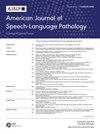A Goal-Writing Framework for Motor-Based Intervention for Childhood Apraxia of Speech.
IF 2.3
3区 医学
Q1 AUDIOLOGY & SPEECH-LANGUAGE PATHOLOGY
引用次数: 0
Abstract
PURPOSE There are multiple frameworks for goal writing that are applicable to the practice of speech-language pathology. Motor-based speech disorders are a subset of speech sound disorders that are thought to require specific elements of intervention that are typically not addressed in the traditional frameworks used in the clinical setting. The purpose of this tutorial is to review general approaches of goal writing and suggest additional elements that may be used to improve the efficiency and effectiveness of treatment for childhood motor speech disorders, specifically childhood apraxia of speech (CAS). METHOD Existing models of goal writing were reviewed to ascertain elements common to most of these models. A basic framework was chosen and modified to include behaviors, conditions, and approaches to goal measurement tailored to the clinical needs of children with CAS. A resource for clinical decision making for children with CAS was developed to inform goal writing at the onset of treatment and adaptations that occur over the course of treatment. Case studies are presented to demonstrate how the presented framework can be applied to writing goals for motor-based treatment for two different children with CAS. DISCUSSION Children with CAS require a specialized approach to intervention, which requires goals to reflect the unique clinical needs of this population. This tutorial offers resources that use the best available research evidence and current understanding of effective treatment practices for CAS to guide clinical decision making for motor-based intervention and goal writing. This tutorial is intended to guide treatment planning across varied settings to facilitate progress and optimize treatment outcomes for children with CAS.以运动为基础的儿童语言障碍干预的目标编写框架。
目的有多种适用于言语病理学实践的目标书写框架。以运动为基础的言语障碍是言语声音障碍的一个子集,被认为需要特定的干预要素,而这些要素通常在临床环境中使用的传统框架中没有涉及。本教程的目的是回顾目标书写的一般方法,并提出可用于提高儿童运动性言语障碍(尤其是儿童言语失禁(CAS))治疗效率和效果的其他要素。方法回顾现有的目标书写模型,以确定大多数这些模型的共同要素。我们选择了一个基本框架,并对其进行了修改,使其包括行为、条件和目标测量方法,以满足 CAS 儿童的临床需求。为 CAS 患儿开发了临床决策资源,为治疗初期的目标书写和治疗过程中的调整提供参考。案例研究展示了如何将所介绍的框架应用于为两名不同的 CAS 患儿编写基于运动的治疗目标。本教程利用现有的最佳研究证据和当前对 CAS 有效治疗实践的理解,为基于运动的干预和目标书写的临床决策提供指导。本教程旨在指导不同环境下的治疗计划,以促进 CAS 儿童的进步并优化治疗效果。
本文章由计算机程序翻译,如有差异,请以英文原文为准。
求助全文
约1分钟内获得全文
求助全文
来源期刊

American Journal of Speech-Language Pathology
AUDIOLOGY & SPEECH-LANGUAGE PATHOLOGY-REHABILITATION
CiteScore
4.30
自引率
11.50%
发文量
353
审稿时长
>12 weeks
期刊介绍:
Mission: AJSLP publishes peer-reviewed research and other scholarly articles on all aspects of clinical practice in speech-language pathology. The journal is an international outlet for clinical research pertaining to screening, detection, diagnosis, management, and outcomes of communication and swallowing disorders across the lifespan as well as the etiologies and characteristics of these disorders. Because of its clinical orientation, the journal disseminates research findings applicable to diverse aspects of clinical practice in speech-language pathology. AJSLP seeks to advance evidence-based practice by disseminating the results of new studies as well as providing a forum for critical reviews and meta-analyses of previously published work.
Scope: The broad field of speech-language pathology, including aphasia; apraxia of speech and childhood apraxia of speech; aural rehabilitation; augmentative and alternative communication; cognitive impairment; craniofacial disorders; dysarthria; fluency disorders; language disorders in children; speech sound disorders; swallowing, dysphagia, and feeding disorders; and voice disorders.
 求助内容:
求助内容: 应助结果提醒方式:
应助结果提醒方式:


